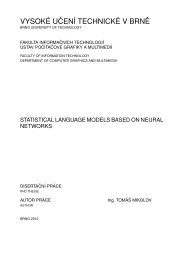Biometric Security Systems: Fingerprint and Speech Technology
Biometric Security Systems: Fingerprint and Speech Technology
Biometric Security Systems: Fingerprint and Speech Technology
You also want an ePaper? Increase the reach of your titles
YUMPU automatically turns print PDFs into web optimized ePapers that Google loves.
of ridge & furrow structures in recovered areas <strong>and</strong> so prepare image for minutiae<br />
extraction algorithm. Then the directional array is found in the image using<br />
filtering in frequency domain (FFT → Ikonomopoulos filter → IFFT).<br />
3. Performance of the image preprocessing. It is a preparatory step for minutiae<br />
extraction <strong>and</strong> classification. Thresholding by RAT scheme (Regional Average<br />
Thresholding) <strong>and</strong> thinning (by Emyroglu) is performed in this step.<br />
4. <strong>Fingerprint</strong> classification. In this step the fingerprint is assigned to one of five<br />
classes. The classification is a difficult process for the machine as well as for the<br />
human, because for some fingerprints it is very complicated to unambiguously<br />
choose the particular class. At first the Karhunen-Loève transformation is applied<br />
on the directional array obtained from the step 2. Then the PNN classifier<br />
(Probabilistic Neural Network) is applied, which assigns the fingerprint into one of<br />
five classes.<br />
5. Minutiae extraction. Here we use the Emyroglu extractor, which extracts only<br />
three types of minutia from the fingerprint skeleton – ridge ending, continuous line<br />
<strong>and</strong> bifurcation. In this step some improvements have been done. When the<br />
detection <strong>and</strong> extraction phase is finished, the minutiae are tested once more. If<br />
they lie on the edge of the fingerprint, they are deleted. The second test checks the<br />
papillary line continuity (partially done in step 3) – difference between line ending<br />
<strong>and</strong> bifurcation. And the last improvement includes more accurate scale for<br />
gradient of the minutia. Now it is possible to detect the degree of the bias of the<br />
papillary line more accurately <strong>and</strong> compute the gradient of this minutia.<br />
6. Verification. It is the comparison of two minutiae sets. The efficiency of the<br />
minutiae comparison algorithms strongly depends on the reliability of minutiae<br />
obtaining process <strong>and</strong> external comparison process. For the minutiae comparison,<br />
we use the Ratha method that tolerates e.g. rotation, translation <strong>and</strong> other changes<br />
in the fingerprint.<br />
Speaker recognition<br />
The speaker recognition part consists usually of four steps: a recording, a signal preprocessing,<br />
a feature extraction <strong>and</strong> recognition.<br />
Recording<br />
The first step of the speaker recognition is the recording of the signal. This is usually<br />
done by a sound hardware which should be able to sample a sound with a sampling<br />
frequency at least of 11 kHz <strong>and</strong> a precision of 16 bits. A quality recording may affect<br />
the results of the recognition. In case of an insufficient hardware capabilities may be<br />
the recognition false.<br />
5







